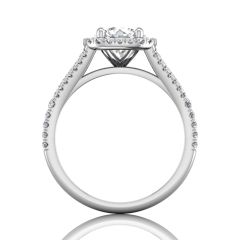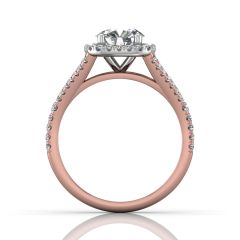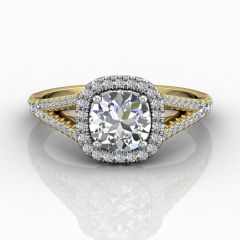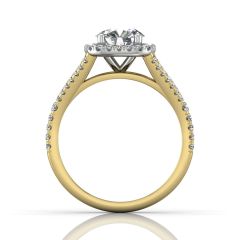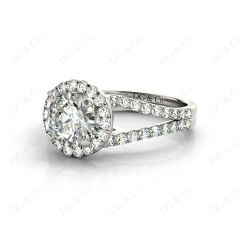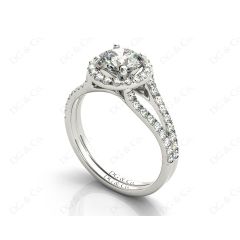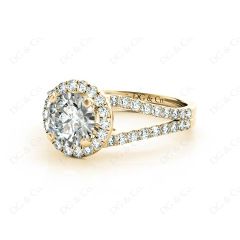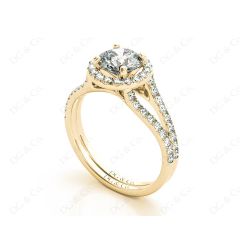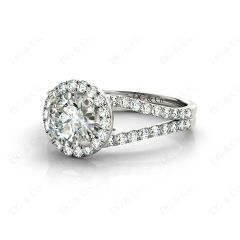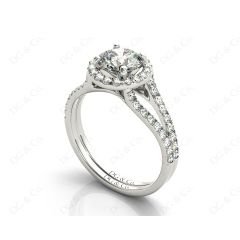Split Shank Engagement Rings
What is a Split Shank Engagement Ring?
Split shank engagement rings refer to a split at the shank of the ring, forming two or more bands in the engagement ring. Split shanks can come in metal only and side stone options for rings. This style offers a contemporary design and is a very customisable style.
Read More
What to Consider When Buying a Split Shank Engagement Ring?
When buying a split shank engagement ring, you should consider many different things. The list below outlines some key things to consider:
- Gemstone
When buying a split shank engagement ring, the gemstones or diamonds are one of the most important considerations for your split shank style. The type of gemstone you choose for your split shank style is crucial, whether you want a diamond, sapphire, ruby, or other gemstones. After choosing a stone, it’s important to look at the 4 C’s: Cut, Colour, Clarity, and Carat weight. The sizes of the diamonds and/or gemstones, whether it’s 0.5 carat, 0.75 carat, 1 carat, 1.5 carat, or 2 carat, should fit your budget and preference for centre stone size and quality. The shapes of your centre stones, such as Round, Oval, Cushion, Emerald, and Marquise cut, also affect the overall design of your split shank style.
-
Setting
There are three main setting options for split shank engagement rings: Prong, Bezel, and Tension settings. Prong settings are the most popular for split shank engagement rings, with 4, 6, and 8 prong variations being common. Tension settings are another option and are unique, but only certain shapes can be set in a tension setting. Bezel settings come in full bezel and half bezel alternatives; they are the safest option and are great for those who are clumsy and prone to damaging their ring. The perfect setting for a split shank engagement ring depends on your preference and the benefits of the different settings.
-
Metal
Platinum and gold are the two main metal choices for those interested in a split shank engagement ring. Platinum has a beautiful silver colour and is very durable. Gold comes in 9k, 14k, and 18k options, along with white, yellow, and rose gold colours. Consider the metal type you like, the different colours, and the durability of the metal or its karat when choosing a metal for your split shank engagement ring.
-
Side Stones
A key consideration when purchasing a split shank engagement ring is side stones. Side stones can come in two options; the first being pavé setting, which offers side stones held in place by prongs or beads, and are the most popular option for engagement rings. The second is channel setting, where grooves are made in the metal where the side stones are placed and the pressure from the metal on both sides keeps them in place. Opting for no side stones is also an option, to go for an all metal look on the split shank of your ring.
Why Should I Buy a Split Shank Engagement Ring?
Buying a split shank engagement ring comes with many advantages. Firstly, the design's ability to give the impression of a larger centre stone is particularly appealing. The inherent durability of a split shank ring ensures its longevity, making it a reliable choice for daily wear and those with active lifestyles and for those prone to knocking the ring. The customisation options available are a significant pro, allowing for a personalised touch in terms of metals, stones, and intricate embellishments. However, it's important to consider potential drawbacks. The design can be hard to clean due to its intricate structure, requiring extra care in maintenance. Additionally, some individuals may find split shank rings to be 'wide' or 'chunky,' which may not align with preferences for more dainty designs. There's also a propensity for snagging, as the openness of the ring design increases the risk.
What are the Pros of Buying a Split Shank Engagement Ring?
There are three main pros of buying a split shank engagement ring:
-
Enhances the Centre Stone: A split shank engagement ring gives the perception of a larger centre stone, making it a brilliant choice for those wanting to get the most out of their centre stone. By splitting the band as it approaches the setting, the ring accentuates the main gem, providing a visual effect that enhances the perceived size of the centre stone.
-
More Durable The durability of a split shank engagement ring is another one of its pros. The design distributes the stress on the band more evenly, reducing the risk of wear and tear over time. This not only enhances the ring's lifespan but also offers peace of mind for those with active lifestyles, making it an excellent choice for lasting beauty and durability.
Customisable in a Variety of Ways The versatility of a split shank engagement ring opens up a world of customisation possibilities. From the choice of metals to the arrangement of side stones or intricate embellishments, the style can be personalised to reflect the unique style of the wearer.
What are the Cons of Buying a Split Shank Engagement Ring?
There are some potential cons to consider when buying a split shank engagement ring:
-
Extra Maintenance Cleaning a split shank engagement ring might pose a challenge due to the intricate design. The divided shank can create narrow spaces that are difficult to reach. This can make routine maintenance and cleaning more time-consuming, requiring extra care to ensure all parts of the ring are thoroughly cleaned.
Can Be Chunky Split shank engagement rings can be perceived as 'wide' or 'chunky' in their appearance. This might not appeal to individuals seeking a more delicate or minimalistic design. The division of the shank into multiple bands can create a bolder and more substantial look, and while some may appreciate this larger design, others may find it less in line with their preference for a daintier and simpler style.
Prone to Snagging The open design of split shank engagement rings, characterised by the divided band, can make them more prone to snagging. The spaces between the shank's components and any protruding elements increase the likelihood of catching on clothing or other objects. This potential for snagging can be a consideration for those with an active lifestyle or those who are quite clumsy and are prone to knocking their ring.
How Much Does a Split Shank Engagement Ring Cost?
A split shank engagement ring at DG & Co. Jewellery costs between $1,233 and $4,385 for the style alone. When choosing a diamond or gemstone centre stone, this can significantly increase the cost, especially for a large high-quality diamond or precious gemstone. The average split shank engagement ring with a centre stone costs around $8,000 to $12,000.
What are the Most Popular Split Shank Engagement Rings?
The best split shank engagement rings ultimately depend on each person's preferences, but our most popular designs are listed below:
- Round Cut 4 Claw Split Shank Engagement Ring with Grain Set Side Stones in 18K Yellow
- Round Cut Halo Diamond Engagement Ring Split Band with Four Claws Set Centre Stone
- Round Cut Halo Flower Diamond Engagement Ring Split Band with Claw Set Centre Stone in 18K White
- Oval Cut Split Shank Diamond Engagement Ring Four Claw Setting Centre Stone Pave Setting Side Stone In18K White Gold
- Diamond Sapphire Halo Engagement Ring Triple Band Pave Setting
- Round Cut Split Shank Milgrain Halo Engagement Ring with Micro Pave Set Diamonds on the Halo and Sidestones in 18K White
- Round Cut Split Shank Milgrain Halo Engagement Ring with Micro Pave Set Diamonds on the Halo and sidestones in 18K Yellow
- Oval Cut Double Halo Diamond Engagement ring with claw set centre stone in 18K Rose
- Round cut diamond ring with claw set centre stone in 18K White
What are the Alternative Styles to Split Shank Engagement Rings?
There are many alternative styles to a split shank engagement ring. Some of the most common alternative styles are twisted band, halo, double halo, and three stone; they can all also feature split shanks in their engagement ring styles.
Free Shipping
Lifetime
Guarantee
Complementary
Valuation
Conflict Free
Diamonds

30 Day Money Back
Guarantee
DG & Co. Guarantees
Free Shipping
Lifetime
Guarantee
Complementary
Valuation
Conflict Free
Diamonds

30 Day Money Back
Guarantee
Contact Us



